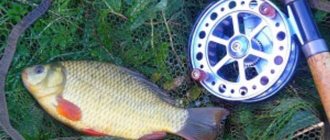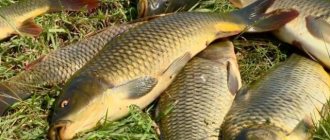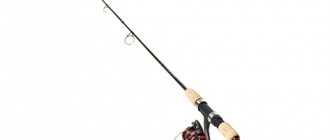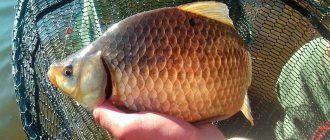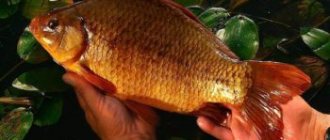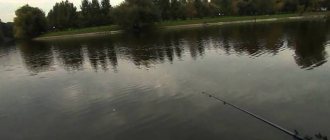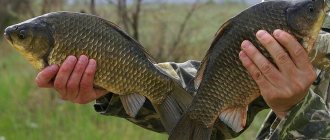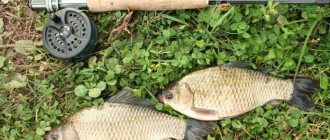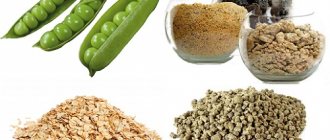Although it is hard to believe, crucian carp can be caught using ordinary foam balls. Of course, this requires special equipment, because fishing with foam plastic is not practiced with a regular float rod, and it is not technologically feasible. The advantage of such a bait is that you can catch as many fish as you like with one ball until the foam flies off the hook, and if it does, it’s not a big loss. Therefore, it turns out that fishing is not very expensive. If you find a piece of polystyrene foam, you can make a lot of these balls out of it. In this case, polystyrene foam of the lowest density is taken. It will not be possible to pick out balls from denser foam.
Tackle for catching crucian carp using polystyrene foam
To catch crucian carp using foam plastic, you will need bottom tackle with a spring-shaped feeder. Although many anglers believe that the “nipple” may be the most effective. The “crucian carp killer” tackle consists of several “spring” type feeders, located one after the other, so this option will be considered.
Before casting the tackle, the spring is stuffed with bait, and foam balls are placed on the hooks. As a result, it turns out that the pieces will be in the water column above the feeder due to positive buoyancy. The crucian carp will definitely become interested in the contents of the feeder and begin to eat its contents.
At the same time, when the crucian carp is feeding, the hooks with foam plastic are very close, since the length of the leashes can be only 5 cm. Having occupied the feeder, the crucian carp also swallows foam balls. As a result, the fish ends up on the hook. It self-cuts under the influence of the weight of the feeder. There are several versions among fishermen about the reason that crucian carp swallows foam balls:
- The crucian carp gets carried away with eating the contents of the feeder and at the same time swallows a foam ball. It's hard to say what the white ball reminds him of. It is quite possible that he sees a balloon in it and decides to swallow it in order to replenish his air reserves. There are also foam balls covered with a shell of different colors and smells. If the ball is similar to a pea or a grain of corn, then everything is clear: the crucian carp will not refuse such a delicacy. Having swallowed such a ball, the crucian carp immediately ends up on the fisherman’s hook.
- There is another opinion, which is based on the fact that crucian carp is still able to determine how edible the bait is. If everything is clear with multi-colored balls, since they can look like ripe peas, green peas, or corn and can smell the same, then with ordinary foam balls, on the contrary, nothing is clear. Most likely, the crucian carp has determined that there is some kind of garbage flying around its feeding area that needs to be removed. In addition, this garbage interferes with normal feeding and the crucian carp takes this ball into its mouth and tries to move it away from this place. So he ends up on the hook.
Equipment
Equipment for catching crucian carp using polystyrene foam is sold in any fishing store. There are many varieties, including the “crucian carp killer” rig. Other accessories, such as “pacifiers,” may be suitable for this purpose, but this is not for sale, since you can easily make it yourself. If you don’t want to spend precious time making equipment, then it’s better to buy, especially if funds allow. There can be 2-3 hooks near each feeder spring, although many fishermen attach up to 6 hooks. If they are secured correctly, on short leashes, they will not get tangled.
For the equipment to work correctly, it is necessary to properly secure the leashes with hooks. Usually they are attached to both sides of the feeder. On a purchased feeder, the hooks may not be tied as needed for fishing with foam, so they will have to be moved to another place. The most important thing is that the length of the leashes does not exceed 5 centimeters. As practice shows, this is the optimal length of leashes for such gear.
Rod
Since this is a bottom tackle, it must be equipped with any fishing rod, either a spinning rod or a feeder rod. Naturally, a feeder rod will cost much more. Many fishermen still use old Soviet spinning rods with inertial reels. Unfortunately, they are not suitable for catching crucian carp, since you will have to frequently re-throw the tackle, and it is difficult to determine bites on them. The fact is that bite detection is carried out by the movement of the rod tip. In this case, the softer the rod tip, the more sensitive the tackle, and old spinning rods are very rough and rigid.
Coil
For such fishing conditions, it is better to opt for a spinning reel. There are no special requirements for the reel, but it must be powerful, since you will have to throw significant weight over a long distance. The reel should fit at least 50 meters of fishing line, 0.3 mm thick. Spool size 2500-3000. This will be quite enough.
fishing line
Despite the fact that mostly you come across individuals that weigh no more than 150-200 grams, fishing line thinner than 0.25 mm cannot be used. A feeder filled with bait can weigh up to 100 grams and when casting, a thinner line simply won’t hold up.
Hooks must be attached to elastic leashes. It is better to use a thin white cord for this, although fishing line about 0.15 mm thick will do.
Fishing with foam. Equipment for fishing with foam plastic. Bottom tackle. Fishing. Fishing.
Equipment for fishing with foam balls
A closed installation is preferred, i.e. the feeder is attached with a latch at the end of the main line. In this case, changing the feeder with leashes will not be difficult. Leashes in the amount of 2 pcs. tied to the feeder along the edges by its main axis, so that it becomes possible for the hooks to float up regardless of which side the feeder lies on the bottom.
Foam fishing equipment
Selecting hooks for fishing
It is necessary to take into account that fish prefer small floating food, and increasing the size of foam balls will not automatically increase the size of the caught fish, or rather, lead to a decrease in the number of bites. As a result, the hook must be lightweight, made of thin wire, so that a small ball of foam can lift it. If we are talking about fishing for carp itself, then in this case you will have to use a hook of increased strength and with large foam balls. But you still need to start fishing, using light equipment with small polystyrene foam, so as not to scare away the fish that could be caught. Thin hooks with a straight hook and a short shank, numbers 10 - 18, are suitable.
Selecting fishing line
Using braided line as the main line is not advisable. There is no need for accurate transmission of the bite; the fisherman will have enough information about the fish’s self-hatching. An expensive cord that doesn’t stretch will only create problems when fishing for large fish, and will also make a hole in finances, due to the fact that when fishing it is better to use three or four of the same type of gear at once. A monofilament of 0.25 millimeters in size with a shock leader (a 6 m end segment of a thicker fishing line) made of braid or monofilament of at least 0.35 mm is suitable as a central fishing line.
Foam fish feeder
It is possible to use an open feeder with a load on one side. Such a feeder is placed on one metal-weighted side, so the bait, as well as the hooks with foam, are on top, which reduces the likelihood of tangling the equipment. Although this option also hides a significant drawback. Loading such a feeder will “eat” a portion of the useful mass that could become the mass of bait. And for this method of fishing, the more food, the better. It seems optimal to use a coiled spring feeder with a length of at least 11-12 cm and a diameter of approximately 1.8 cm. The weight of the feeder with bait should be 125 - 175g.
Feeder for fishing on foam plastic
Leash
A short or extremely short leash is preferable, due to the fact that the bait should not move away from the feeder at a distance of more than 3.5 cm and look to the fish like a floating lump unconnected with the food. When using two leashes, the hooks should also not touch to avoid tangling. It would be a good idea to make leashes from thin braid, so that the distance from the connection point on the feeder to the hook is 2.5 - 5.5 cm. And fishing experience shows that, for example, crucian carp, almost 4 times more often Enough polystyrene foam that practically lies on the bottom. Fishing is more successful with a long leash that gets tangled and ends up short!
Styrofoam
There are entire sets of foam balls on sale in a variety of scents and colors. As already noted, it is more advisable to use small polystyrene foam. Also, the smell should not be very different from the food offered. If you use vanilla as a bait flavoring, then it is better to use foam balls of the same flavor. In my opinion, “Hemp” and “Honey” work better. The foam balls are put on the hook so that the barb of the hook and the sting completely pass through the foam ball and are free. Having swallowed the foam plastic, the fish, together with the floating particles of food, as a rule, always self-cuts with the sharp tip of the hook. Before fishing, it is necessary to test in a bucket of water how the buoyancy of the chosen polystyrene foam, as well as the hook and the leash, compare.
Foam balls of different sizes and colors
Bait for fishing with foam balls
A muddy and dusty composition is preferable.
- milk powder – 0.5 parts;
- breadcrumbs - 1 share;
- corn flour - 0.04 parts;
- ground flour - 0.04 parts;
- wheat bran – 0.03 parts.
It is necessary to moisten the bait from a reservoir with water to such a state (selected experimentally) that it can be stored in the feeder for up to 45 minutes.
How much foam do you need to hang on the hook?
Fishermen who have heard that crucian carp are caught using foam plastic also try to catch them, but in doing so they make one mistake. When hooking a foam ball, they don’t think about keeping it and the hook in the water column. As a result, the foam ball turns out to be too small and cannot lift the hook, or a heavy hook made of thick wire is used and the foam ball is not able to lift it. Therefore, the hook along with the foam sinks to the bottom and the likelihood that the fish will bite is practically zero. Therefore, before casting the tackle, you need to check whether the hook with foam plastic is sinking. It may happen that one large ball is enough, but sometimes you have to put 2 or 3 small balls in the form of a bead. To check, just throw the tackle into the water near the shore, where the depth is not great and the bottom is visible. If the hook with the ball rises and is placed in the water column, then everything is in order. If the hook does not come off the bottom, then you need to add foam or use another hook made of thin wire.
Fishing stores sell foam balls of any color and with any flavor. Because the foam is encased, it does not have the same characteristics as regular white foam. To use purchased foam, you will have to use hooks with a long shank and made of thin wire, since you will have to attach at least 2 or 3 balls. At the same time, balls of various sizes are sold, which allows you to choose balls for any occasion.
How to make a feeder - a spring for catching crucian carp with your own hands
Success in catching crucian carp and crucian carp depends on various factors. But the correct supply of bait comes first. When the feed mixture is supplied by the fisherman to a small fished area, the fish will quickly concentrate at this point. And if there is a hook with bait on the bait spot, then you won’t have to wait long for a bite.
Read Zherlitsa with your own hands
For fishing in standing waters, a spring feeder has proven itself to be excellent. It is quite simple to make from wire. Moreover, using wire of different thicknesses, you can get a whole arsenal of springs with different volumes and weights.
To make a spring feeder, you need to stock up on available materials and tools.
The wire can be made of any metal, but it is best to use copper or brass products. They are easy to use, do not corrode, and finding these types of wire is not difficult. The wire thickness is suitable in the range of 1-3.5 mm. It is better to make the first springs from thin and soft material. Then you can successfully work with thicker wire.
To make a sliding crucian carp feeder you will need a tube. It can be made from the core of a ballpoint or gel pen, a Chupa Chups candy stick, or from a metal tube.
You will need pliers or wire cutters to cut off the wire. It will be more convenient to bend large-diameter wire with round-nose pliers.
The simplest device for winding wire in the form of a spring is a rod, bolt or other cylindrical object.
To equip the spring, a piece of 0.3 mm monofilament line 50 cm long, as well as a rubber stopper or a lead pellet, is suitable.
How to attach foam to a hook
When placing foam on a hook, the main condition is that the tip of the hook is always open. Moreover, no matter how many balls are placed on the hook. Under this condition, the fish will always catch on the hook. If this is not done, then the chances of the fish being detected are very small. In this case, fishing may not be effective.
Catching crucian carp with polystyrene foam means that it hooks itself. When he gets hooked, he tries to get away, but the weight of the feeder prevents him from doing so. As a result, the hook thoroughly hooks the fish, after which it will no longer be able to leave the hook. But she continues to try, as evidenced by the movement of the rod tip. The fisherman can only begin to reel in the fishing line, pulling the next crucian carp ashore. Since there may be more than one hook, there may be as many crucian carp. Therefore, fishing with polystyrene foam is very effective. The main thing is to choose strong, thin, but sharp hooks. As a rule, imported hooks from well-known companies have similar characteristics. Domestic hooks are not suitable for this type of fishing.
Catching carp and crucian carp using flavored foam plastic
What kind of fish can you catch using foam?
Foam fishing is characterized by a tendency towards versatility, not only in the direction of the bait, but also in the direction of the object of hunting. After all, using this type of bait, the catch may include both peaceful fish and some species of predator. The category of peaceful fish caught on foam plastic imitations includes all carp. For some types of fish, fishermen have developed specialized fishing strategies with their own nuances of technical design, equipment and special equipment.
Crucian carp, carp, bream, roach, and silver bream are among the main prey items. Bleak, gudgeon, rudd, ide, and chub confidently complement the presented list of species. Among the predators caught on foam plastic imitations are perch and pike perch, especially if fishing occurs on currents when the bait is animated by strong jets of water. Using the possibilities of the current, many representatives of salmon fish are caught in natural conditions, on fast streams and rivers. Grayling and trout happily pick up colorful foam peas playing in the streams of water.
Using bait
For a more active bite, when catching crucian carp, various types of bait are used. These can be either purchased, ready-made mixtures or home-made ones. For those who do not want to stand at the stove and cook porridge, it is enough to purchase bait at a fishing store. Moreover, it is not necessary to ask the seller anything, since each package indicates what kind of fish the bait is intended for catching. Of course, if you constantly buy bait in the store, then fishing can turn out to be “golden”. In this regard, many fishermen practice preparing their own bait.
Naturally, you need to know what bait should be for crucian carp. In addition, the specifics of fishing with a spring require bait, which has a special consistency. The fact is that the bait from such a feeder is quickly washed out. In this regard, you need to compact the bait tightly into the feeder. But this still does not guarantee effective fishing, since the bait must open after some time. Thus, a feeding spot will be formed, which will keep the crucian carp at the fishing point. Therefore, each time it is necessary to throw the tackle in the same place.
Many fishermen do not particularly prepare baits with a large number of ingredients. They practice preparing porridge containing a couple of ingredients, or even prepared from one grain, for example, pearl barley. At the same time, they do not stand at the stove, but steam the barley in a thermos. This method is convenient because you don’t have to spend a lot of time on preparation. Barley is filled with boiling water before going fishing. In the time it takes to get to the reservoir, the pearl barley is ready for use. Near the pond, dry ingredients are added to it, for example, makha (cake), to bring the bait to the desired consistency. You can also get water here if needed.
In any case, if you prepare the bait yourself, it will be much cheaper, since most of the ingredients can be found in the kitchen.
If you look on the Internet, you can find a lot of different recipes that do not contain scarce ingredients.
Crucian carp on FOAM!!! Fishing for crucian carp on a NIPPER Tackle NIPPLANT
Where else can foam plastic help out?
Fishing with foam can be effective even in cases where fishing with classic baits does not produce any results. As a rule, polystyrene foam is effective in reservoirs with heavily silted bottoms. What's the matter here? But the fact is that, falling to the bottom, the feeder can gradually sink into the silt along with the nozzle. As a result, the crucian carp simply will not notice them. Experienced fishermen, knowing what's going on, twitch the rod from time to time, causing the feeder and the hook with the nozzle to move at the bottom. The task can be greatly simplified if you use polystyrene foam. It can be placed next to the main bait, and it will no longer drown in the mud. If everything is calculated correctly, then you can generally raise the hook with bait above the bottom, which will make fishing effective.
Catching fish such as saberfish requires that the bait be in the water column, since sabrefish do not feed from the bottom. It attacks the bait either at the moment when it slowly sinks to the bottom, or when it is in the water column. And here foam plastic can also help out. The main thing is to insert such an amount of foam so that the hook can rise from the bottom and can be in the water column. Then you can guarantee bites from other fish, such as grass carp or silver carp.
Selection of gear and installation
Installing fishing gear for polystyrene foam is no different from installing fishing gear with other baits. To a greater extent, this bait is used for fishing reservoirs with bottom gear, hooks and feeders. Float tackle is used much less frequently and for smaller species of fish. Flying, Bolognese and match gear are selected based on the size of the fish planned to be caught and the range of bait delivery. Mono lines up to 0.15 mm are used as the main cords. The floats and loading systems themselves depend on the fishing conditions and the bait has no influence on their selection. Hooks are used the size of a pea and try to use in light colors. For example, a steely metallic color goes well with white tones.
Important! Tackle for fishing with polystyrene foam for the bottom fishing method is equipped based on the volume and, accordingly, the mass of the feeder and the strength of the current in the reservoir.
The bait also does not have much influence on the composition of the rig. The only nuance is the use of soft, but memoryless monofilaments on leashes no thicker than 0.12 mm, which allows the balls to play along with the currents more naturally and more confidently float up from the silt deposits after casting. Carp are caught on heavy rods equipped with powerful traction reels. Feeder gear for roach can be equipped with a light pickerel with a reel for monofilament. Hooks for single baits are taken with a curve, without a forearm, based only on the diameter of the pea. Garlands of imitation boilies are placed on hooks with a long shank or using hair equipment.
